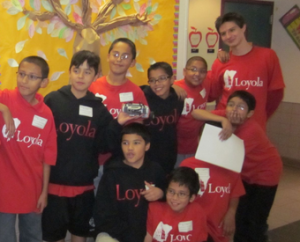In many ways and for a variety of reasons, I’ll take a top-down approach to research when looking at ways to improve retention rates amongst Hispanic students at private, Catholic and prep schools. One of these ways will be reading articles centered on retention rates of Hispanic students at post-secondary schools. First off, there is more research out there on supporting Hispanic students at colleges than there is at prep schools. And secondly, if I can discern ways to support Hispanic students succeed in college, certainly many if not all of the methods utilized could be used to support Hispanic students at college prep schools as well. I think that the tangential relationship between retention rates at both of these types of schools is correlative, especially since one type of school builds to the other.
I found one such article by G.M. Stern (2008) on Mercy College, a small college in up-state New York, and its attempt to recruit and retain Hispanic students. I’d like to think that an article about Hispanic college students in New York is relevant to my findings in Phoenix because I’d love to send my high school students back East for college. I think there is value to leaving one’s home state and seeing who you become away from home. One of my best Hispanic students is leaving us this fall to study engineering at Swarthmore on a full scholarship. He’s someone I’ll be interviewing for my research as well.
From Stern (2008), I found it interesting to learn that, “Of all undergraduates enrolled at Mercy, Hispanics comprise 29 percent of the student body, more than double the percentage of Latinos in the U.S. population. Last year, U.S. News & World Report named Mercy one of the seven most racially and ethnically diverse colleges in the North” (p. 2). This college in New York seems like one to keep an eye on because it is obviously doing something right when it comes to recruiting and retaining Hispanic students. One thing Mercy seems to do well is to do a lot of discernment of which students will do succeed at their college prior to students even enrolling. Stern (2008) has written, “The college is seeking students that fit Mercy regardless of their ethnic background” (p. 1). This suggest that Mercy has a strong of sense of self, knowing which students will succeed at their college because they’ve reflected upon this thoroughly prior to their enrollment process. This sounds like an important first step as schools try to better retain Hispanic students on their campuses: know thyself, to borrow a phrase from the ancient Greeks.
Organization
The author’s article was organized well and easy to follow. The headings were helpful, especially ones like “Retention Strategies.” I also found it helpful that some of its headings guided me to Mercy students where the article discussed how the students found success at the college. For instance there was Karen Quijano. Stern (2008) wrote of Quijano, “She didn’t apply to large campuses with 30,000 or so students because she considered the numbers too intimidating” (p. 3). I think that Quijano’s example goes back to Mercy College’s front-end recruitment of students they know will have success at their college. There doesn’t seem to be a point to recruiting in bulk. Rather, be it secondary or post-secondary, it seems best to really do research on the students early on in the enrollment process.
Literature Review
Stern’s article was not a bastion of well-researched theory on Hispanic education as it pertains to Mercy College, so in this case, I found his literature review somewhat lacking. Stern’s research centered on Mercy College itself, interviewing faculty, students, and administrators on the things it does well. It wasn’t just that, though. Stern also analyzed data relating to Mercy College in the context of the state of New York and colleges in general. Still, I didn’t find the depth of theory regarding why Hispanic students might do well at this college. I’m not sure if this is a negative thing or not. I plan on discussing ideas like indigenous methodologies in my research paper, but I also would like to have some “boots on the ground” data so to speak regarding tangible information from schools that are successful in recruiting and keeping Hispanic students.
Data Collection
As intimated in the previous section, Stern’s data, for the most part, comes from the analysis of college retention numbers at the school, data related to other colleges in New York and back East on the whole. Stern (2008) wrote, “Despite all of its efforts and successes, Mercy College can’t retain all of its Hispanic students. Though 29 percent of students enrolled are Latino, only 18 percent of its graduates are Latino. Why don’t the other 11 percent graduate?” (p. 5). After presenting this information, Stern went on to analyze the results and answered his own question by anecdotal evidence and interview data.
Analysis
Stern did a nice job of allowing others to do his analysis for him. Just as I previously mentioned, the author asked questions like the one above and used more knowledgeable sources to provide answers. Stern (2008) wrote here, transcribing the thoughts of Carolyn Tragni, Mercy College’s assistant vice president for academic support, “’Some Latino students come in with barriers. They’re working to support families, sending money back to families, coming out of high schools that may not have prepared them for college – and for some, English isn’t their native language. We struggle like any college to retain a higher number of students’” (p. 11). The data provided by Stern supports that Mercy College is doing a good job of retaining its Hispanic students. What Tragni relates here is that each year attrition will happen with Hispanic students. I’d like to not accept this answer, and I’d like to find methodologies to offset some of the things that Tragni mentioned in this article as hindrances to Hispanic students finding success in college.
Theoretical Framework/Lens
Stern wrote his article as a researcher and inquisitor. I feel that he wrote as a reporter as well. Reporters tend to be devoid of opinions and simply want to parlay facts to readers. I found that here to some respect. His writing style does seem to distance himself from his readers. Still, the subject matter and research shows that Stern cares about the topic – or else he would not have taken the time to write about this college and its success with regards to the issue of Hispanic education. Reporters find that they must cover, for instance, car crashes or fires for whatever news source he or she works for. This topic does not cry out for public consumption and so Stern’s interest in bringing it to the attention of others proves that he does care for the population it relates to. I will say, though, that he seems very conscious of trying to relate facts and best practices without himself being a part of the data. This, I believe, only strengthens his findings.
Findings & Conclusions
Stern, through using this small college in New York, has found two things that interest me in my pursuit of finding better ways to recruit and retain Hispanic students at private, prep, and Catholic secondary schools. First off, know your own school and student body well and find students who fit profiles of success at your school. This seems very important. Schools must consciously reflect upon what types of students can and will do well by reflecting upon the types of successful graduates it has had previously. Once this reflection occurs, the rest follows much more smoothly. Secondly, support your students. Stern (2008) quoted the assistant vice president once again, “What’s the key to attracting Latino students to a private college? The ‘holistic’ approach works best, Tragni said, combining one-on-one assistance from an advisor, identifying problems early, providing academic support and offering career development” (p. 12). I think one-on-one advisors, which is, of course, not something unique to other colleges and universities is vital here with Hispanic students, but, more so, it centers on how well these advisors are utilized. Students at post-secondary or secondary private schools need means of support throughout the entire school process. From Stern’s piece I’ve gleaned that the front-end recruitment process seems the most important with multiple means of support as something that is imperative as well.
References
Stern, G. M. (2008). Mercy College: A retention model for Hispanic students. The Hispanic
Outlook in Higher Education, 18, 55-57. Retrieved from http://search.proquest.com
/docview/219229155?accountid=41434



